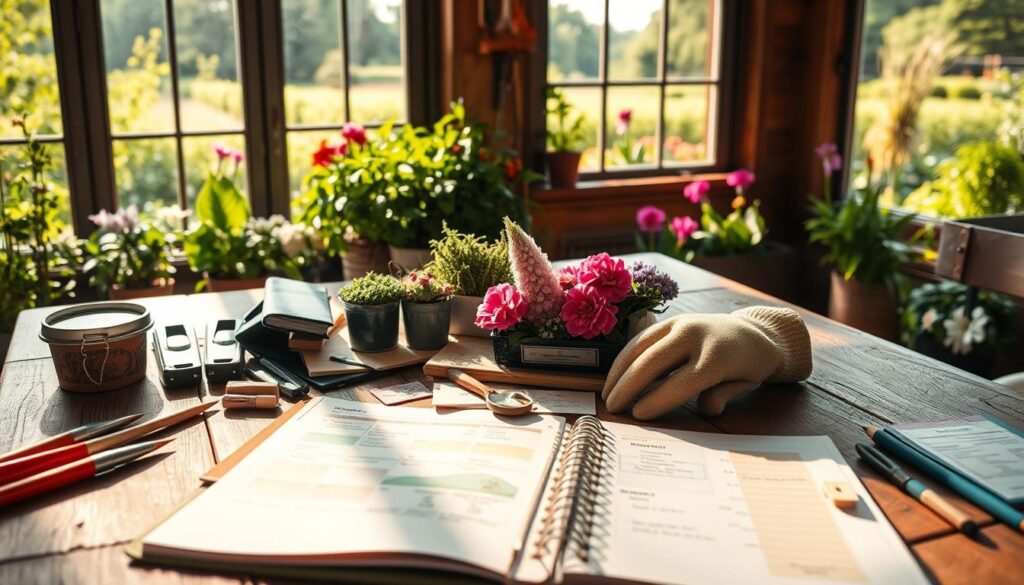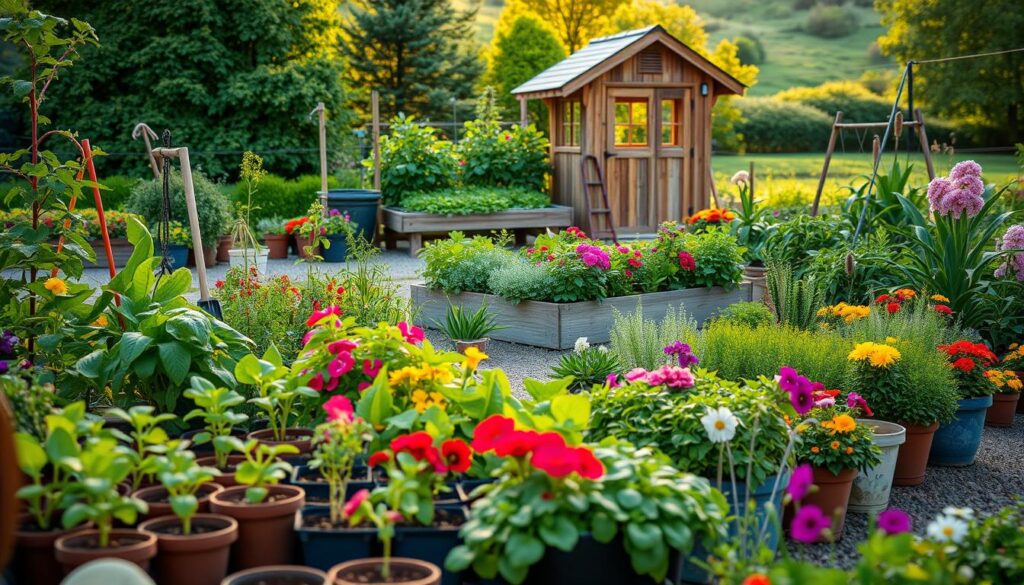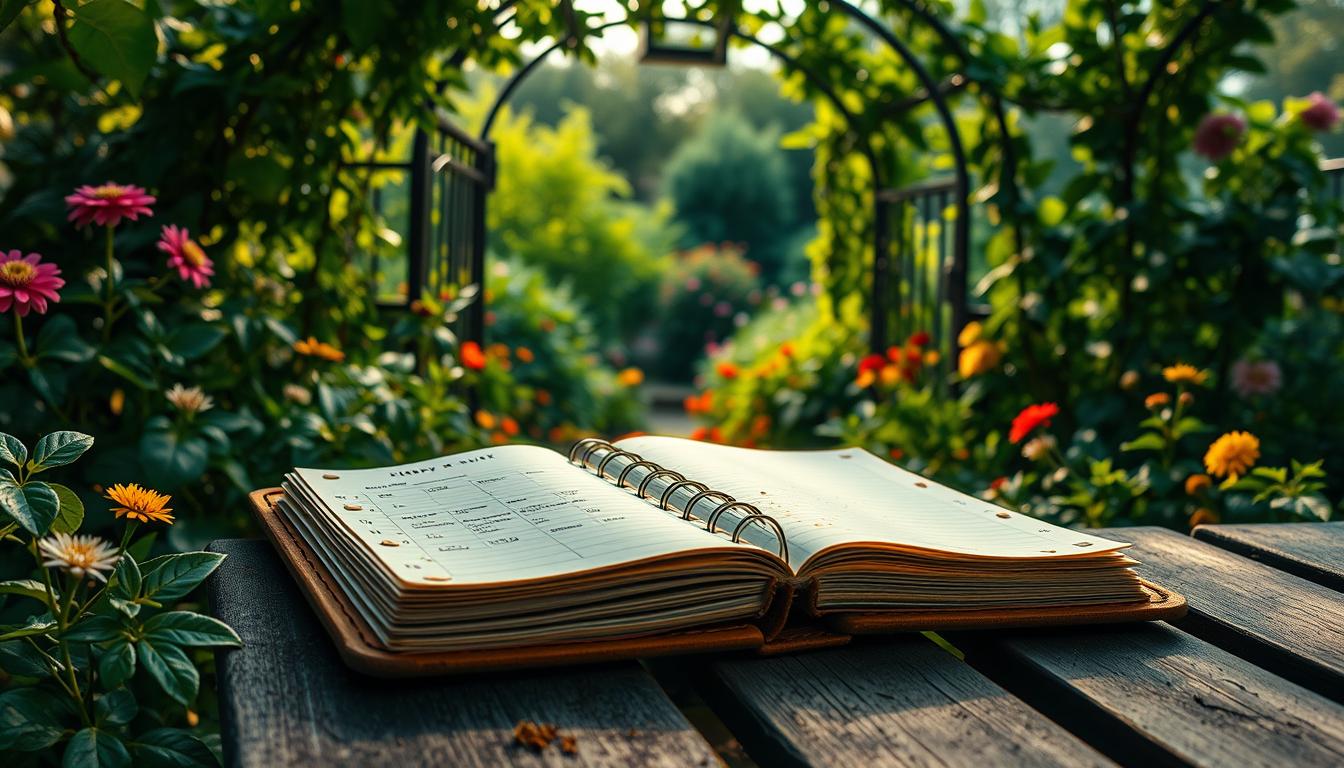Planning your outdoor space can be both exciting and overwhelming. A well-organized guide can make all the difference, especially during the winter months when preparation is key. With a 38-page binder designed for multi-year use, you can track crop rotations, plant varieties, and seasonal changes effortlessly.
These planners offer space for seed catalog cuttings and inspiration clippings, making it easy to visualize your ideal layout. Whether you’re a beginner or an experienced gardener, these tools adapt to your evolving needs. They’ve even helped transform urban spaces into thriving green areas.
Structured planning ensures you stay on top of every detail, from planting schedules to harvest timelines. With everything in one place, managing your outdoor space becomes a breeze.
Key Takeaways
- Printable planners simplify year-round garden management.
- 38-page binders track crop rotations and seasonal changes.
- Visual planning includes space for seed catalog cuttings.
- Planners adapt to evolving layouts over multiple seasons.
- Structured planning has transformed urban gardens successfully.
Why Gardening Printable Planners Are Essential for Every Gardener
Managing your outdoor space effectively requires the right tools and strategies. A well-designed planner can help you stay organized, track progress, and customize your approach to suit your needs. Whether you’re a seasoned gardener or just starting, these tools are a game-changer.

Stay Organized Throughout the Seasons
One of the biggest challenges for gardeners is keeping track of seasonal changes. A planner helps you stay on top of planting schedules, crop rotations, and weather patterns. By referencing the USDA plant hardiness zone map, you can avoid costly mistakes and ensure your plants thrive.
For example, zone-specific planting calendars guide you on when to sow seeds and when to expect harvests. This level of organization saves time and ensures your outdoor space is always at its best.
Track Progress and Plan Ahead
Tracking your progress is essential for long-term success. With a planner, you can document seed-to-harvest timelines, compare yields, and note preservation methods. This data helps you make informed decisions for future seasons.
Consider recording soil amendments and fertilizer schedules to optimize plant health. These templates make it easy to see what works and what doesn’t, giving you a clear path to improvement.
Customize Your Garden Planning Experience
Personalization is key to making your planner work for you. Add herb labels, color-coded crop markers, or even stickers and washi tape to make it uniquely yours. These small touches not only make planning fun but also help you stay motivated.
For urban gardeners, planners can optimize small spaces like 4×4 raised beds. Case studies show how structured planning can turn limited areas into productive green spaces.
Beyond practicality, planners also offer mental health benefits. They reduce winter blues by giving you a creative outlet and a way to look forward to the growing season.
- Zone-specific planting calendars prevent costly mistakes.
- Track seed-to-harvest timelines and compare yields for better results.
- Customize with stickers, washi tape, and color-coded markers.
- Optimize small spaces with detailed planning templates.
- Improve mental health by staying organized and inspired.
How to Make the Most of Your Gardening Printable Planners
Transform your outdoor space into a thriving haven with the right planning tools. Whether you’re working with a small urban area or a larger farm-scale layout, these planners can help you stay organized and inspired. Here’s how to use them effectively.

Choose the Right Planner for Your Needs
Not all planners are created equal. For urban spaces, look for templates that focus on vertical solutions and compact layouts. If you’re growing edible plants, opt for planners with companion planting charts to improve yields. For ornamental designs, artistic layouts with pressed flowers or leaf rubbings can add a creative touch.
Incorporate Creative Elements Like Stickers and Washi Tape
Adding personal touches makes planning more enjoyable. Use washi tape to mark succession planting dates or create grid lines. Stickers can highlight key tasks or milestones. These small details not only make your planner functional but also reflect your love for your outdoor space.
Use Planners to Document Garden Inspiration
Your planner can also serve as a mood board. Include photos from public gardens or create plant profiles with care instructions and pest management notes. Track climbing vegetables like tomatoes or document seed viability charts. This way, your planner becomes a comprehensive guide and a source of inspiration.
By following these tips, you’ll turn your planner into a valuable tool that helps you achieve your outdoor goals. With the right advice and a bit of creativity, you’ll find planning to be both practical and rewarding.
Tips for Successful Garden Planning with Printable Resources
The key to a flourishing garden lies in thoughtful planning. Using printable resources can help you stay organized and achieve your goals. Here are some practical tips to make the most of your planning process.

Start with a Clear Garden Layout Sketch
Begin by sketching your garden layout. Use grid paper templates scaled for common bed sizes, like 4’x3′ layouts. This helps you visualize plant placement and spacing. For example, tomatoes need 2-3 feet of space, while lettuce can be planted closer together.
Include paths and access points in your sketch. This ensures you can reach every plant without stepping on the soil. A clear layout saves time and prevents overcrowding.
Research Your Plant Hardiness Zone
Knowing your plant hardiness zone is crucial for success. The USDA zone map provides advice on which plants thrive in your area. For instance, zone 5 gardeners should avoid planting tropical species that won’t survive frost.
Use zone-specific planting windows from the Almanac to schedule your tasks. This includes last frost dates and harvest targets. Here’s a quick reference table:
| Zone | Last Frost Date | First Frost Date |
|---|---|---|
| 5 | April 30 | October 15 |
| 6 | April 15 | October 30 |
| 7 | March 30 | November 15 |
Set Realistic Goals and Track Your Progress
Start with achievable goals, like growing three tomato plants per person. Track your progress from planting to harvest. This helps you measure success and improve each year.
Use monthly checklists to stay on top of tasks. Include soil amendments, organic fertilizer schedules, and pest control measures. For example, apply compost in early spring and switch to liquid fertilizer during flowering.
By following these tips, you’ll create a garden that’s both productive and enjoyable. With the right advice and tools, your planning process will become a rewarding part of your day.
Conclusion: Transform Your Garden with Printable Planners
Bring your garden dreams to life with a structured approach. Multi-year binder systems allow you to track your garden’s evolution, from seed to harvest. These tools are perfect for gardeners who love to see progress over time.
Winter planning rituals, like flipping through seed catalogs with a cup of tea, can be a soothing way to prepare for the growing season. Daily journaling in your planner also serves as a mindfulness practice, offering mental health benefits.
Share your journey with others by joining garden tour groups or swapping tips with fellow gardeners. These planners are adaptable, making them ideal for life changes like moving homes or welcoming a new family member.
Ready to start? Sign up for our newsletter and receive free starter pages to kick off your planning. Visit NewGen Living for more resources to enhance your garden experience.

